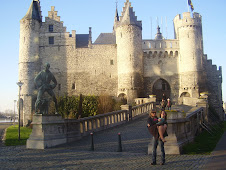
Hello, It´s my second blog, but first in english. Why It's always so hard to begin writing a new blog? :) I would like to tell you something about a country I was born in. Georgia is a Eurasian country in the Caucasus located at the east coast of the Black Sea. It is bordered on the north by Russia, on the south by Turkey and Armenia, and on the east by Azerbaijan.
You can find a lot of information about Georgia in internet, I only want to show the most beautiful places and cities. My first post is about the capital of Gergia - Tbilisi.
Tbilisi (the capital of Georgia& the city I was born in), that is situated in the mountain valley on both banks of the Mtkvari (Kura) River, is the largest cultural and industrial centre in Georgia. There have been preserved numerous specimen of ancient architecture in Tbilisi, including the Metekhi Church, the Sioni Cathedral, the Narikala Fortress and others.
Barocco and Classicism, Pseudomauritian style and specific Asian architecture co-exist on parallel streets of Tbilisi - this beautiful and amazing farpost of Europe.
NARIKALA FORTRESS
The Narikala Fortress dates back to the 4th century A.D. Several times it was destroyed and rebuilt. The fortress consists of two walled sections on a steep hill between the sulphur baths and the botanical gardens of Tbilisi.The fortress was badly demaged in 1827 by earthquake. In the end of the 20th - the beginning of the 21st centuries Narikala was restored and partly rebuild to lock tourists and natives who really love the place and the spectacular views from the fortress.
 Photo©uncorneredmarket
Photo©uncorneredmarketSIONI CATHEDRAL
The Sioni Cathedral dates back to the 6th - 7th century. It was also destroyed by foreign conquerors several times. One of the relics of the cathedral is St.Nino's cross. According to legend St.Nino converted Georgia into Christianity in 337 A.D.
METEKHI CHURCH
The Metekhi church dates back to the 5th century. There is a monument to Vakhtang Gorgasali, the founder of Tbilisi, near the church. Metekhi used to be the residence of the king and actually had another name. The name "Metekhi" dates back to the 12th century and literally means “the area around the palace”.
The Metekhi Church of Assumption was built by king St.Demetrius II ca 1278-1284. The Metekhi church is a cross-cupola church. It was the most common style throughout the Middle Ages, but the Metekhi church is somewhat anachronistic with its three projecting apses in the east facade and the four freestanding pillars supporting the cupola within. Tradition holds that it was also a site where the 5th-century martyr lady Saint Shushanik was buried. However, none of these structures have survived the Mongol invasion of 1235. Legend has it also that the Metekhi cliff was a site of the martyrdom of Habo (8th century), Tbilisi’s patron saint.

MOUNT MTATSMINDA (The Holy Mountain)
A beautiful view of Tbilisi opens from Mount Mtatsminda, where a fine park is laid out. Half way to the top of Mount Mtatsminda, on one of its slopes stands St.David's Church, built in 1855. The Pantheon of Writers and Public Figures is close by. It is possible to reach the Pantheon on foot or by cable railway, the funiculair, right from the city centre.
At the foot of Mount Mtatsminda is the central district of Tbilisi - Rustaveli Avenue, the Government House of Georgia, The Parliament, the Kashveti Church of Saint George, the Picture Gallery, the Rustaveli Academic Theatre, the Opera Hou§se and other attractions of this beautiful city.
Traditional Georgian balconies


Typical yard




























5 comments:
very nice blog
Thanks for the Info and Great Photo's
Excellent photo's
Guide to Caucasus: Georgia, Armenia and Azerbaijan - destinations, sights, tours & outdoor adventures. Visit also Gudauri ski hotels booking
Hallo thank you ....!!!!!!!!!!!
Very nice pictures (all country )
Vladimir Germany
Post a Comment